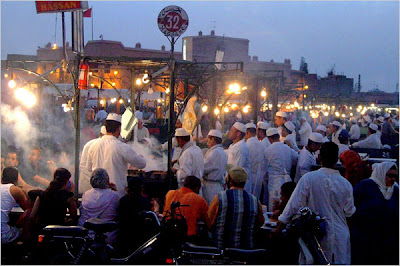Eric Beecroft completes his report on the VII Seminar in Pasadena:
"After Stanley Greene's phenomenal projection, the schedule called for Digital Railroad and Apple technical seminars- which I didn't attend. It's not that I'm interested; it's that I'm not a tech-head, and it wasn't anything stunningly new or revolutionary.
The post lunch session was a new feature for VII Seminars, now in its sixth or so incarnation: a group showing by young(ish) photographers called
"the new photojournalists." These photographers were as diverse as could be in style and content; the only similarity was their strong dedication to the craft (in terms of lifestyle, not just a career), and their amazing ability.
Work was shown by Boogie, Jessica Dimmock, Marcus Bleasdale and Stephanie Sinclair. All of the work was very good; particularly touching was the multimedia piece shown by Jessica Dimmock of her book titled
"the Ninth Floor", a long term project on heroin addicts inhabiting an apartment in New York City. It so moving that I saw some tears in the audience.
Stephanie Sinclair showed her work on child marriages. Her presentation was special to me, as she spoke of an accident her mother had - an event which led her directly into conflict photography. Maybe it's just my preference for "humanness" from the photographers, but Stephanie's passion, breaking voice and the obvious emotional consequences of doing this work which really made an impression on me and on the audience.
Marcus's work was a mix of incredible still photos mixed in with gathered audio and video clips from his decade spent in the Congo documenting the conflict there (four million lives lost since 1998); his story on how he started photojournalism was also inspiring- quitting his secure banking job in his mid 20s, buying a ticket to the Balkans, and just going there.
It was also a mixed bag as far as education went- Boogie and Marcus are essentially self taught, with not much of formal photographic eduction- whereas Stephanie and Jessica both followed a more formal course of study. Stephanie was a top newsspaper photographer for seven years before venturing to Iraq; she ended up staying for 2 years, then resettling in Lebanon, and doing the work she really believes in. It just proves that there are many paths to the work we do, none one right for everyone- and all of these photographers are incredibly talented and driven, no matter their background or degrees.
The seminar ended with two show stopping presentations by two veteran- and I'd say almost preternaturally talented- conflict photographers in the world. Ron Haviv, who in my opinion, gave one of the most powerful talks of the seminar. He addressed the photographers' responsibility to document by creating awareness of the world's problems. This was ilustrated with examples from his ten years of work during the Balkans conflict. His photography documentation was crucial evidence against Serbian war criminals during the Hague's war crimes trials, and has almost cost him his life. Ron recounted how the notorious warlord Arkan had a hit out on Ron's head; he was subsequently interrogated, beaten and mock executed by guards in a shack in the woods, and his release had to be arranged by the Russian and French governments.
Further examples of our obligation to produce work with meaning and that creates awareness- and hopefully produces change- came from a great multimedia piece on Los Angeles' gangs and on the crime waves that afflict certain neighborhoods. Ron also showed his most recent work on the long term conflict in Sri Lanka. Not only are his images amazing, but more so, to me, was his absolute and passionate dedication for photojournalism. He practices what he preaches.
Last to present was the living legend Eugene Richards. Unfortunately. I couldn't stay for his whole presentation , as I was exhausted from the long nights and all day onslaught of powerful imagery. For what I saw, his work deserves the legendary label, and he is truly the artist of the VII crew, focusing on social issues and much lesser problems almost all in the United States. Issues from drugs to domestic abuse to cancer and the elderly were shown; Eugene showed through his work that you don't have to travel long distances to foreign lands to tell amazing, powerful, necessary stories- they are right in your backyard.
Let me end with a wrap up of the best quotes (at least those I can remember) from the Seminar. All the presenters, locals and students were marvelous. I'd just like to thank some specifically by name for their generosity, patience with my (at times overeager and very energetic) photo-j students, and for the portfolio reviews, feedback, discussions, dinner, and inspiration that they gave to all who were there. Extra huge thanks to Ron Haviv, Stanley Greene, Chris Morris and his wife; Rick Loomis, Mike Robinson Chavez, Stephanie Sinclair, Marcus Bleasdale, Boogie, Ben Lowy, Jessica Dimmock, Gary Knight, Joachim Ladefoged, Frank Evers, Lauren Greenfield, and the rest.
Now for the quotes:
Boogie:
Just go out and shoot...its on the street, right in front of you.Gary Knight:
The photographer's job is to be useful. Stanley Greene:
What you have to do is go, keep trying. I'm not attracted to violence, I'm interested in questions- what makes people do these things...are those things inside of me? I'm a storyteller, with picture, When I started out...I was very bad. People told me I should be a disc jockey. The minute you push the button, you create history. This is what I was made to do; to be a photographer until I die. To close: rumors are flying, but expect VII seminars internationally, perhaps Europe, maybe Mideast, maybe Asia...who knows ? If you ever have the chance to go, you've got to do it. It's worth much more then the modest admission cost and travel, and it leaves one inspired, working to improve, and with lifelong friends."
Eric Beecroft













































